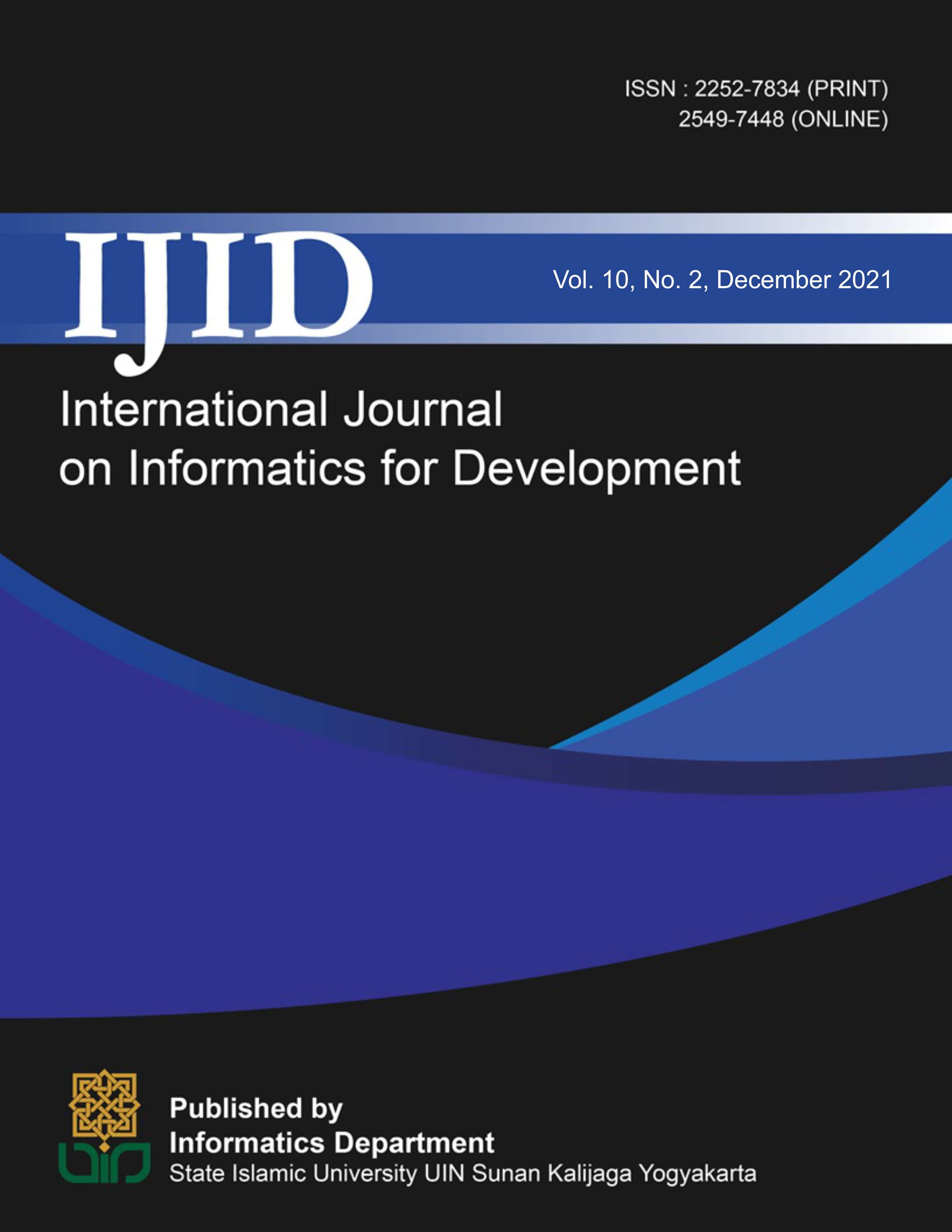Abstract
The recognition of Arabic handwriting is a challenging problem to solve. The similarity among the fonts appears as a problem in the recognition processing. Various styles, shapes, and sizes which are personal and different across individuals make the Arabic handwriting recognition process even harder. In this paper, the data used are Arabic handwritten images with 101 sample characters, each of which is written by 15 different handwritten characters (total sample 101x15) with the same size (81x81 pixels). A well-chosen feature is crucial for making good recognition results. In this study, the researcher proposed a method of new features extraction to recognize Arabic handwriting. The features extraction was done by grabbing the value of similar features among various types of font writing, to be used as a new feature of the font. Then, City Block was used to compare the obtained feature to other features of the sample for classification. The Average accuracy value obtained in this study was up to 82%.
References
A. Farhat et al., “Optical character recognition on heterogeneous SoC for HD automatic number plate recognition system,” Eurasip J. Image Video Process., vol. 2018, no. 1, 2018.
J. Memon, M. Sami, R. A. Khan, and M. Uddin, “Handwritten Optical Character Recognition (OCR): A Comprehensive Systematic Literature Review (SLR),” IEEE Access, vol. 8, pp. 142642–142668, 2020.
H. Ghaleb, P. Nagabhushan, and U. Pal, “Segmentation of offline handwritten Arabic text,” pp. 41–45, 2017.
F. Qomariyah and F. Utaminingrum, “The Segmentation of Printed Arabic Characters Based on Interest Point,” Advencement Res. Circuit Syst. Int. Conf., pp. 2–6, 2016.
M. O. Assayony and S. A. Mahmoud, “Integration of Gabor Features with Bag-of-Features Framework for Arabic Handwritten Word Recognition,” 2017 9th IEEE-GCC Conf. Exhib. GCCCE 2017, pp. 1–4, 2018.
S. Ahmed Medjahed, “A Comparative Study of Feature Extraction Methods in Images Classification,” Int. J. Image, Graph. Signal Process., vol. 7, no. 3, pp. 16–23, 2015.
M. Abdelnafea and S. Heshmat, “Efficient Preprocessing Algorithm for Online Handwritten Arabic Strokes,” Proc. 2019 Int. Conf. Innov. Trends Comput. Eng. ITCE 2019, no. February, pp. 64–69, 2019.
A. Lawgali and A. Bouridane, “Handwritten Arabic Character Recognition: Which feature extraction method,” Int. J. Adv. Sci. Technol., vol. 34, no. September, pp. 1–8, 2011.
M. A. Abdullah, L. M. Al-Harigy, H. H. Al-Fraidi, M. a Abdullah, L. M. Al-harigy, and H. H. Al-fraidi, “Off-Line Arabic Handwriting Character Recognition Using Word Segmentation,” J. Comput., vol. 4, no. 3, pp. 40–44, 2012.
A. Sahlol and C. Suen, “A Novel Method for the Recognition of Isolated Handwritten Arabic Characters,” arXiv Prepr. arXiv1402.6650, 2014.
R. S. Bahri and I. Maliki, “Perbandingan Algoritma Template Matching Dan Feature Extraction Pada Optical Character Recognition,” J. Komput. dan Inform., vol. 1, no. 1, pp. 29–35, 2012.
R. I. O. Ahmed and M. E. M. Musa, “Preprocessing Phase for Offline Arabic Handwritten Character Recognition,” Int. J. Comput. Appl. Technol. Res., vol. 5, no. 12, pp. 760–763, 2016.
D. M. Jacquerye, “Proposal to encode Javanese and Sundanese Arabic characters,” 2019.
F. Qomariyah, F. Utaminingrum, and W. F. Mahmudy, “The segmentation of printed Arabic characters based on interest point,” J. Telecommun. Electron. Comput. Eng., vol. 9, no. 2–8, pp. 19–24, 2017.
F. Damayanti, S. Herawati, Imamah, F. A. M, and A. Rachmad, “Indonesian license plate recognition based on area feature extraction,” Telkomnika (Telecommunication Comput. Electron. Control., vol. 17, no. 2, pp. 620–627, 2019.
D. A. Prabowo and D. Abdullah, “Deteksi dan Perhitungan Objek Berdasarkan Warna Menggunakan Color Object Tracking,” Pseudocode, vol. 5, no. 2, pp. 85–91, 2018.
K. Kumar, R. K. Mishra, and D. Nandan, “Efficient Hardware of RGB to Gray Conversion Realized on FPGA and ASIC,” Procedia Comput. Sci., vol. 171, no. 2019, pp. 2008–2015, 2020.
M. Balsky, “Luminance values extraction from digital images,” Proc. 2016 IEEE Light. Conf. Visegr. Countries, Lumen V4 2016, pp. 1–3, 2016.
S. Bhahri and Rachmat, “Transformasi Citra Biner Menggunakan,” J. Sist. Inf. dan Teknol. Inf., vol. 7, no. 2, pp. 195–203, 2018.
J. Yoo, I. Karpov, S. Lee, J. Jung, H. S. Kim, and H. Hwang, “Threshold Voltage Drift in Te-Based Ovonic Threshold Switch Devices under Various Operation Conditions,” IEEE Electron Device Lett., vol. 41, no. 1, pp. 191–194, 2020.
Y. Kim, Y. Lee, and M. Jeon, “Imbalanced image classification with complement cross entropy,” Pattern Recognit. Lett., vol. 151, pp. 33–40, 2021.
M. Wang, L. Zhenglin, S. Fuyuan, and G. Lei, “An Improved Image Thinning Algorithm and Its Application in Chinese Character Image Refining,” no. Itnec, pp. 1870–1874, 2019.
Abhisek and K. Lakshmesha, “Thinning approach in digital image processing,” Last Accessed April, pp. 326–330, 2018.
R. M. Haralick, “A Fast Parallel Algorithm for Thinning Digital Patterns,” vol. 27, no. 3, pp. 236–239, 1984.
T. Vardoulaki, M. Vakalopoulou, and K. Karantzalos, “Per city-block, density estimation at build-up areas from aerial RGB imagery with deep learning,” 2017 Jt. Urban Remote Sens. Event, JURSE 2017, pp. 0–3, 2017.

This work is licensed under a Creative Commons Attribution-NonCommercial-NoDerivatives 4.0 International License.
Copyright (c) 2021 IJID (International Journal on Informatics for Development)

